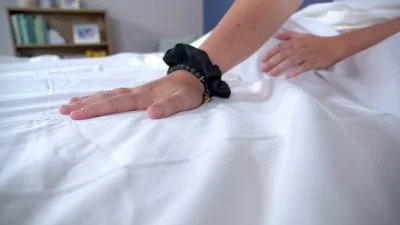
If you have been shopping for sheets, you probably noticed that many sheets — especially those claiming to be high-quality — will list their thread count. It seems like a higher thread count is better, or at least that is the common knowledge many of us have learned. But is that really true? Is a higher thread count better? What is a thread count anyway?
Let’s break it down.
What is Thread Count?
Back to basics: what even is thread count? Thread count literally refers to the count, or number, of threads in a square inch of fabric. This number is calculated by adding together the number of threads going horizontally (the weft) and vertically (the warp) in a square inch of woven fabric.

Weaving — if you aren’t a crafter or fiber artist — is a type of textile production in which two yarns are interlaced to cross each other, generally at a right angle. It is distinct from other types of textile production, such as knitting, crocheting, or braiding.
When it comes to the number of threads in the weft and warp, they can be the same or different. For example, a 500-thread count sheet could have 250 threads in the warp and 250 in the weft. Or, you could have 200 threads in the warp and 300 in the weft and the thread count would still be 500.
Another way you can think about thread count is it’s a measure of how tightly woven a fabric is. More threads means more tightly woven, and less threads is less tightly woven. If there are fewer threads used overall, the fabric won’t be as dense — which is why some lower thread count styles of sheets are more breathable than higher thread count styles.
Types of Woven Fabric
Woven sheets can be made from a variety of different materials, such as cotton, bamboo, linen, Tencel, and so on. Whichever material is used, there are three main types of weave that you will find among sheets:
- Percale, which is a one thread over, one thread under style of weave. — check out our favorite percale sheets.
- Sateen, which is generally three or four threads over, one under.
- Twill, which uses diagonal parallel ribs, created by passing the weft thread over one or more warp threads and then passing it under two or more warp threads.
(If you’re in the market for new sheets, check out our best percale sheets, our best sateen sheets, or some of our favorite twill sheets, like the Cariloha Bamboo sheets.)
Not all fabrics used to make sheets are woven fabrics, so there are a number of sheet styles that won’t have a thread count. One example is jersey, a common type of sheet made from a knit fabric.

What is the Best Thread Count?
Now that we know what a thread count is, let’s go over its significance. Like I mentioned before, many people believe that the higher the thread count is, the better the sheet is. But that is not always the case.
Materials make a difference.
Synthetic materials like polyester will rarely feel as soft or as high-quality as cotton, even if the thread count is higher. And rougher textiles like wool will always feel scratchy, even if the thread count is super high.
Even among cotton, long-staple will be much smoother, softer, and more durable than short-staple cotton. That’s because longer fibers won’t stick out, which can create a rougher surface and lead to pilling. So even if the listed thread count is high, be sure to take a closer look at the materials used.

The style of weave matters, too.
For example, a sateen weave — which uses the three or four over, one under style of weave — will naturally have more threads than a percale weave that uses a one over, one under style of weave.
Thread counts can also be distorted.
Some manufacturers will twist two or more thin threads together before weaving, allowing them to double-count those threads. For example, a 200-thread count sheet woven with double threads could be listed as 400-thread count.
Plus, when you think about it, a square inch can only physically hold so many threads. The way that manufacturers achieve sky-high thread counts, like 1800, is by using microfibers. Microfibers’ diameters are smaller than silk’s, which can only be achieved in synthetic fabrics. There are some high-quality human-produced fabrics, like bamboo viscose or Tencel, but cotton sheets will never be able to achieve those ultra-high thread counts without fudging the numbers.
Here’s a quick breakdown of the thread count ranges we recommend for different sheet styles:
- Sateen sheets: 300 to 600
- Percale sheets: 180 to 300
- Twill sheets: 200 to 500
- Linen sheets: 80 to 130
How Does Thread Count Affect Quality?
While thread count is a little more complicated than “higher is better,” it can still tell you a lot about a set of sheets.

For example, the lower the thread count, the more breathable a sheet will generally be. That’s why percale sheets tend to be preferable for hot sleepers over sateen, as the two most common cotton sheet styles. Percale uses fewer threads, creating a crisp, lightweight, and breathable sheet.
However, having a higher thread count can create a softer, more buttery feel. Again, crazy high thread counts are likely deceptive, but thread counts in the 200 to 600 range will generally have a softer feel than sheets with lower thread counts.
Final Thoughts
Thread count is an important thing to consider when buying sheets, but not the only thing. Remember to look at the materials used, the weave style, and keep your eyes peeled for unrealistically high thread counts — which tend to only add a higher price tag, but not higher quality.


























